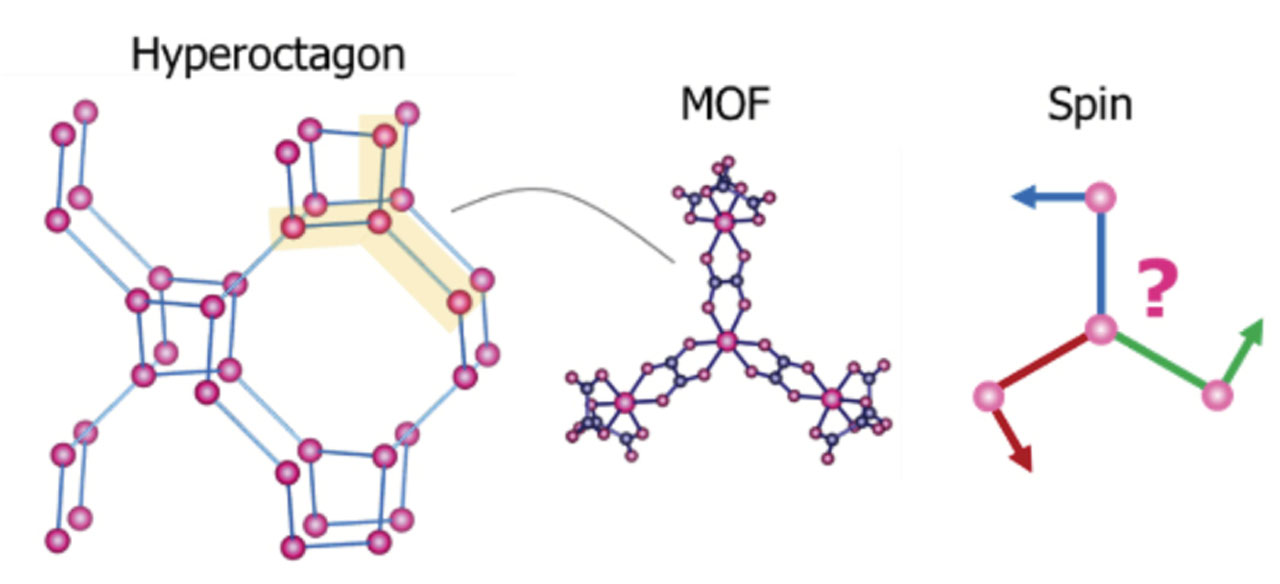Hyperoctagon Cobalt Oxalate MOF as a Platform for Kitaev Spin Liquid Physics
Kindo, Yamashita, and Yamaura Groups
Water becomes vapor or ice when the temperature changes. In the same way, spins change the state and exhibit various magnetic properties when the environment such as temperature and magnetic field changes. Generally, at sufficiently low temperatures, the orientation of the spins aligns like a solid. On the other hand, a state where the spins are not ordered down to the lowest temperatures, despite the presence of sizable interactions between the spins to order their orientations, can be viewed as a liquid state that does not solidify. Such a state is called a quantum spin liquid and has attracted condensed matter physicists as a new state of matter. The most promising theoretical model for realizing a quantum spin liquid state is the honeycomb lattice model proposed by Kitaev [1]. A worldwide research competition involving both physics and chemistry communities is underway to create a material that realizes the Kitaev’s honeycomb model. Thus far, simple inorganic compounds with a two-dimensional honeycomb lattice and their derivatives have been studied exhaustively. On the other hand, it has been pointed out that there are small number of variations of materials and the effect of disorder can be problematic in the layered compounds. Therefore, the development of materials from a new perspective has been desired.
We focus on a three-dimensional honeycomb lattice called a hyperoctagonal lattice realized in a Metal Organic Framework (MOF), which has been studied as an ionic conductor previously. In this MOF, metal ions are linked by the oxalic acid molecules to form a three-dimensional network. A similar situation was theoretically studied in 2017 by M. Yamada, H. Fujita, and M. Oshikawa in the Institute for Solid State Physics at the University of Tokyo, who proposed the realization of a quantum spin liquid [2]. However, no experimental studies have been conducted to date. We selected cobalt as the magnetic element because the effect of the spin-orbit coupling is prominent. We synthesized the crystals of the MOF and investigated the magnetic properties down to low temperatures and in the strong magnetic fields [3].
Our experiments revealed that the MOF with a hyperoctagonal lattice exhibits various spin states as the temperature and magnetic field change. In particular, as the temperature is lowered, a peculiar intermediate temperature state where the spins are not ordered appears, despite the fact that interactions between spins are active. Interestingly, the entropy of the spin is released by about a half around the intermediate temperature region, which is similar to the behavior expected in the theory. This interesting magnetic property should be attributed to the unique cobalt network connected by the oxalic acid molecules, which generates the magnetic interactions to align the spins in different directions for each bonding direction of the hyperoctagon lattice.
It has been proposed that the properties of the quantum spin liquids can be used to perform quantum computation. Our results represent a totally new direction in the development of materials that can be the platform for the quantum computation. The development of MOFs is expected to accelerate the development of materials of the research area.
References
- [1] A. Kitaev, Ann. Phys. (Amsterdam) 321, 2 (2006).
- [2] M. G. Yamada, H. Fujita, and M. Oshikawa, Phys. Rev. Lett. 119, 057202 (2017).
- [3] H. Ishikawa, S. Imajo, H. Takeda, M. Kakegawa, M. Yamashita, J. Yamaura, and K. Kindo, Phys. Rev. Lett. 132, 156702 (2024).

